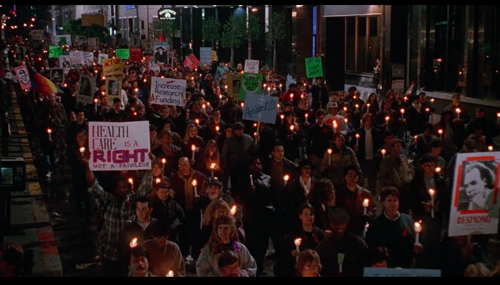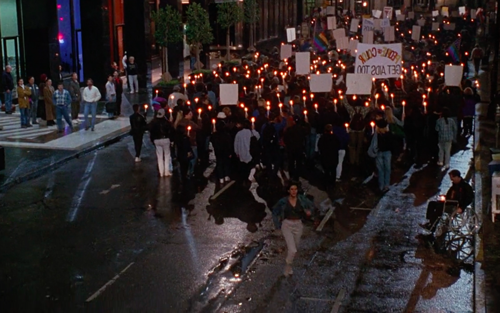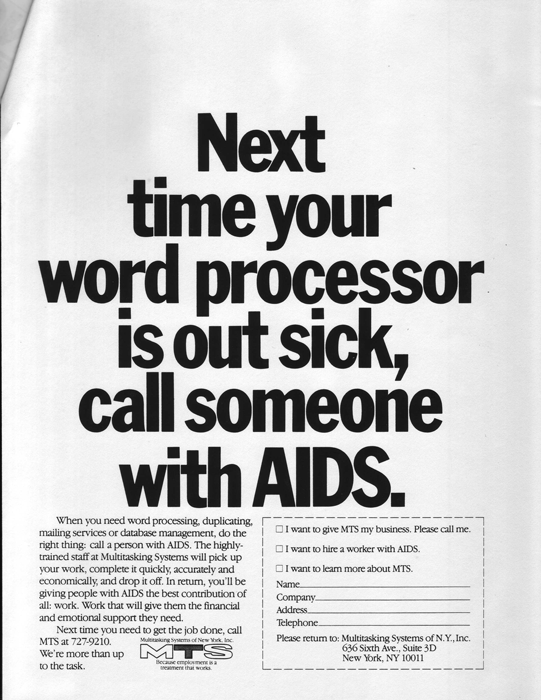Cait McKinney

Irwin Winkler, The Net (still depicting Angela Bennett ordering pizza), 1995.
If you saw The Net when it came out in 1995, you might remember certain Internet wow moments performed by the film’s protagonist Angela Bennett (played by Sandra Bullock). A systems analyst and all-around computer nerd who works from home protecting corporations from hackers, Bennett uses her modem to order a pizza online, a now banal action that was presented as a revolutionary convenience in the 1990s. She also spends a lot of her time ‘cyber chatting’ as ‘Angel’ with other early adopters who have screen names like ‘Cyberbob’ and ‘IceMan.’ They make jokes about abstinence and technological ennui. ‘No one leaves the house anymore. No one has sex. The Net is ultimate condom [sic]’ IceMan writes.

Irwin Winkler, The Net (still depicting ‘Cyberchatting’), 1995.
The Net introduced mainstream audiences, on the cusp of becoming web users, to the Internet as both transformative and terrifying. This was also the year Netscape Navigator—the first user-friendly, freely available web browser—was released to the general public, setting off what is known in media and technological history as the Consumer Internet Revolution. Scores of new dial-up Internet users looked to news reports, For Dummies books, and cinematic representations like The Net in order to understand what this ‘revolution’ might mean.
To model the Internet’s radical possibilities, the film leaned heavily on HIV, privacy and stigma as stand-ins for the risks posed by online data environments that seemed less trustworthy than paper. The film’s action is propelled when HIV testing records are hacked to stigma-shame a high-level member of the US government. This vocally homophobic Republican cabinet member kills himself to avoid the scandal of proximity to the virus, before learning that his records had been altered. Digital information, the film argues, is too promiscuous to be trusted.

Irwin Winkler, The Net (still depicting hacked test results), 1995.
Throughout the film, high-level data infrastructures in the United States are pictured failing: financial records, the FBI’s database, air traffic control, and medical records databases all fall into chaos against a backdrop of HIV/AIDS and its now-iconic protest cultures. During the film’s climax, Angela Bennett escapes her pursuers by darting out of a large tech convention to blend into an ACT UP protest/vigil in downtown Los Angeles. She becomes an anonymous AIDS activist if only for a moment, but does so in order save the Internet.

Irwin Winkler, The Net (still depicting Angela Bennett disappearing into an ACT UP protest, taking place outside a tech conference), 1995. This scene was shot at the 1995 MacWorld convention in San Francisco.

Irwin Winkler, The Net (still depicting Angela Bennett disappearing into an ACT UP protest, taking place outside a tech conference), 1995. This scene was shot at the 1995 MacWorld convention in San Francisco.
The Net is not a film about AIDS. Rather it is part of what Alexandra Juhasz and Ted Kerr have described as the larger “media ecology of AIDS,” which includes films made toward a variety of ends.[1] This film is about networked computing, but it appropriates the North American AIDS crisis—in particular its tropes of stigma and risk—to explain why data ought to matter to the public. In the 1990s, both HIV and the Internet were primary sources of social anxiety around information-management, rights to privacy, and public pedagogy, yet they are rarely thought of together in either media history, or the histories of AIDS. What if the most telling product of blockbuster, Hollywood AIDS cinema from the 1990s was not Philadelphia (Jonathan Demme, 1993) as is often cited, but The Net? Both films follow a privileged, white protagonist ‘fighting the system,’ but Bennett navigates big data and the decade’s emerging network cultures.
This thought experiment lays out some of the questions behind a new research project I am working on that maps Internet history in the 1990s through HIV/AIDS. Despite my focus on The Net above, the broader project studies information activism and Internet service provision by AIDS activists. AIDS activists understood and used networked computing, when it was new, as an essential tool for organizing and rapidly communicating health information within precarious conditions. Queering media history means placing those living with HIV/AIDS—rather than hackers, military researchers, or Silicon Valley titans—at the center of how Internet technologies developed. When we talk about ‘AIDS and Memory,’ from the present, we might need to remember how Internet protocols, values and regulatory contexts were built within conditions of proximity to HIV/AIDS, including the interventions of activists.

Advertisement for MTS Systems, ca. late 1980s/early 1990s. Image Courtesy The John J. Wilcox Jr. LGBT Archives at the William Way Community Center.
When you look for it, as I am doing, the HIV/AIDS collections held in queer community archives turn up all kinds of documents that constitute a computing history of the illness. This advertisement for Multitasking Systems of New York (MTS) was placed in magazines and business publications in the New York City area during the late 1980s and early 1990s.[2] MTS was a non-profit that provided job training ‘to qualified people with AIDS statewide.’[3] This ad invited managers to imagine such workers as potential employees uniquely suited to IT environments. MTS’s programs were founded on liberal, Bush/Clinton-era workfare ideals that imagined a singular, healthy-enough-to-work, AIDS-affected subject with untapped potential and unique technical capacity. Putting people to work, MTS claimed, ‘eliminates the potential for poverty and homelessness among people with AIDS.’[4] Here, computing becomes a solution to an epidemic that MTS argued produced systemic barriers to meaningful employment.
Like The Net, MTS purposefully entangled anxieties about what was new and unknown about HIV and technology: if, and how, both people living with HIV/AIDS and computing’s black-boxed processes could be meaningfully incorporated into workplaces. Word processing is a salient choice for this advertisement. As media historian Matthew Kirshenbaum has shown, during this era, word processers were marketed for their ‘perfection’ (think of ‘WordPerfect,’ a favorite early word processor).[5] The conceit of MTS’s ad—‘Next time your word processor is out sick, call someone with AIDS’—is that the purportedly perfect word processor was actually much less reliable than the unjustly stigmatized human worker. Thrown into, or already living in precarious conditions, this future worker is constructed as adaptable and uniquely suited to wrangling the new technology that no one else in the office could understand.
Desktop computing, web browsing, word processing, and networked database management all became routine media practices over the course of the 1990s. This decade constitutes the consumer Internet’s plasticity stage, a concept developed by media historians such as Jonathan Sterne and Lisa Gitelman to describe transition and adoption as key temporalities for understanding how the media forms we take for granted settle in their particular shapes.[6] The mid-90s also marked a period of widespread adjustment to the virus; new antiretroviral drugs reached wide markets made up by those who could afford them while safer sex campaigns saturated public discourse (Cyberbob’s joke about condom fatigue—‘Let’s have a date and procreate’—pictured above, is case-in-point). This was a contemporaneous period of adjustment—to HIV and to new communications media—in which queer activists mobilized their specialized knowledge practices to understand and intervene in media infrastructures. Thinking about adjustment also orients us to the ways in which new media adoption is rarely revolutionary, but rather caught up in slow processes of adapting existing activist information tactics developed using ‘older’ media, like newsletters. Following feminist scholars like Lauren Berlant and Sarah Sharma, I am interested in the kind of affective work that happens as we adjust, or get-by, within conditions not necessarily of our own making.[7]
How do technologies remember? The title of this essay, ‘Can a computer remember AIDS?’ plays on the ‘memory’ metaphors used in computing: computers have disk-storage utilities that we have learned to call ‘memory,’ but they do not remember as an inventive social practice that produces collective meaning.[8] The title of this special issue ‘AIDS and Memory’ suggests, in part, that cultural processes of remembering have been shaped by AIDS and its legacies; there is not only an AIDS (or many different AIDS) to remember, but also a set of tactics, affects and political commitments at stake when we talk about how AIDS is remembered, and in particular, the time period, geography and shared knowledges Sarah Schulman has named ‘the AIDS of the past.’[9]
Media theory has similarly shown that particular technologies offer attendant memory practices. Wendy Chun has argued that digital media’s conflation of storage as memory ‘glosses over the impermanence and volatility of computer memory.’[10] While the digital was supposed to solve archival problems of degradation and material forgetting, in practice, the digital forgets because it merely stores, or puts information away, to be forgotten, as it were. For Chun, ‘memory is an active process, not static. A memory must be held in order to keep it from moving or fading.’[11] Chun is writing about the technical capacities of digital storage and our tendency to understand them through humanistic memory processes that cannot account for what computers, as machines, actually do. Her thinking is also extendable to the ways humans remember digital technologies, and how digital technologies ‘remember,’—or materialize as technological practices—legacies of struggle. While a computer cannot remember AIDS, the ways that we understand and put networked computing to use can.
The suggestion that ‘memory is an active process, not static,’ that memory must be ‘held’ rather than filed away, is one I extend to AIDS Internet history via archival work. Hard drives store, potentially for access but just as often for redundant backup, while archives are characterized by their orientation toward access.[12] Archival access is particularly vital in the context of HIV/AIDS archives, which have struggled to exist in the first place due to the consequences of AIDS-related death and the compulsory heterosexuality of archival logics.[13] Archives preserve and offer access to records in ways that computers cannot—it is widely known that hard drives fail and obsolete machines become inoperable. Any archive is, of course, a technology of power.[14] As archival logics order cultural memory, they render certain ‘AIDS of the past’ intelligible, often at the expense of others.[15] Mining documents that speak to AIDS activism’s entanglement with emerging internet and computing practices is a material and embodied process—of sifting, sorting, squinting—that attempts to hold onto technological memories of HIV/AIDS, and to activate another kind of AIDS archive. Part of what is at stake in remembering HIV/AIDS activism is a richer understanding of the information management and knowledge mobilization practices activists perform across formats and decades, which come into view partly through archival excavation. As I begin interviewing activists involved with HIV/AIDS Internet projects like Philadelphia’s Critical Path AIDS Project, their memories of the internet’s role in their past work promises to further understandings of new technologies—how, and why, they are adopted.[16]
Our network and data infrastructures—the way we think about privacy, risk and the organizing potential of online media—have all been fundamentally shaped by HIV/AIDS activist cultures as well as the representational tactics of mainstream artifacts like The Net. There is no ‘AIDS and Memory’ without remembering, and I argue, remembering through new media and technology.
[1] Juhasz, Alexandra and Ted Kerr. Home Video Returns: Media Ecologies of the Past of HIV/AIDS, http://www.cineaste.com/spring2014/home-video-returns-media-ecologies-of-the-past-of-hiv-aids/.
[2] Multitasking Systems of New York, Kiyoshi Kuromiya papers on HIV/AIDS Research and Organizations, John J. Wilcox Jr. GLBT Archives of Philadelphia, Box 35, Folder ‘Employment.’
[3] MTS Fact Sheet, Kiyoshi Kuromiya papers on HIV/AIDS Research and Organizations, John J. Wilcox Jr. GLBT Archives of Philadelphia, Box 35, Folder ‘Employment.’
[5] Kirschenbaum, Matthew G. Track Changes: A Literary History of Word Processing, (Cambridge: Harvard University Press, 2016).
[6] Sterne, Jonathan. The Audible Past: Cultural Origins of Sound Reproduction, (Durham and London: Duke University Press, 2003), 181–82; Gitelman, Lisa. Always Already New: Media, History, and the Data of Culture (Cambridge and London: MIT Press, 2006), 1.
[7] Berlant, Lauren. Cruel Optimism (Durham and London: Duke University Press, 2011); Sharma, Sarah. In the Meantime: Temporality and Cultural Politics (Durham and London: Duke University Press, 2014).
[8] Sturken, Marita. Tangled Memories: the Vietnam War, the AIDS epidemic, and the politics of remembering, (Berkeley: University of California Press, 1997).
[9] Schulman, Sarah. The Gentrification of the Mind: Witness to a List Imagination (Berkeley: University of California Press, 2012), 45.
[10] Chun, Wendy Hui Kyong. ‘The Enduring Ephemeral, or The Future is a Memory,’ in Huhtamo, Erkki and Jussi Parikka (eds). Media Archaeology: Approaches, Application, and Implications (Berkeley and Los Angeles: University of California Press, 2011), 195.
[12] David Squires’ work on porn archives includes a useful discussion of archival access, sexuality, and ‘the fantasy of archival space as dead space.’ Squires, David. ‘Pornography in the Library’, in Dean, Tim and Steven Ruszczycky (eds). Porn Archives (Durham and London: Duke University Press, 2014), 85–87.
[13] See Hernàndez, Robb. ‘Drawn from the Scraps: The Finding AIDS of Mundo Meza’, Radical History Review, 122, 2015, 74.
[14] Archive theorists working in the Foucauldian tradition have considered the archive as a technology of social movement memorialization. See, for example, Eichhorn, Kate. The Archival Turn in Feminism: Outrage in Order (Philadelphia: Temple University Press, 2013).
[15] While many scholars of HIV/AIDS history have considered the problem of a singular AIDS Archive, contributors to ‘Forum: Remembering AIDS Coalition to Unleash Power (ACT UP) 1987–2012 and Beyond’, Quarterly Journal of Speech, 98:1, 2012, provide a multifaceted critique of this problem. See in particular contributions by Karma Chàvez’s ‘Act UP, Haitian Migrants and Alternative Memories of HIV/AIDS’, 63–68 and Alexandra Juhasz’s ‘Forgetting ACT UP’, 69–74.
[16] Critical Path was a Philadelphia-based, non-profit service that built what the organization called ‘Community-Based Internet Infrastructure’ in order to provide HIV/AIDS service organizations and those living with HIV/AIDS with free internet access and skills training. For the last year I have been conducting archival research in the papers of Kiyoshi Kuromiya, founder of Critical Path. The MTS ad above is from his personal collection.
Cait McKinney’s work examines the media practices of feminist and LGBTQ social movements, emphasizing the late-twentieth-century adoption of digital and online tools. Recent writing has appeared in Feminist Theory, the Radical History Review, and Little Joe: Queers and Cinema. Cait holds a PhD in Communication and Culture from York University, and is a course lecturer in the Faculty of Information and Media Studies at Western University. http://caitmckinney.com.